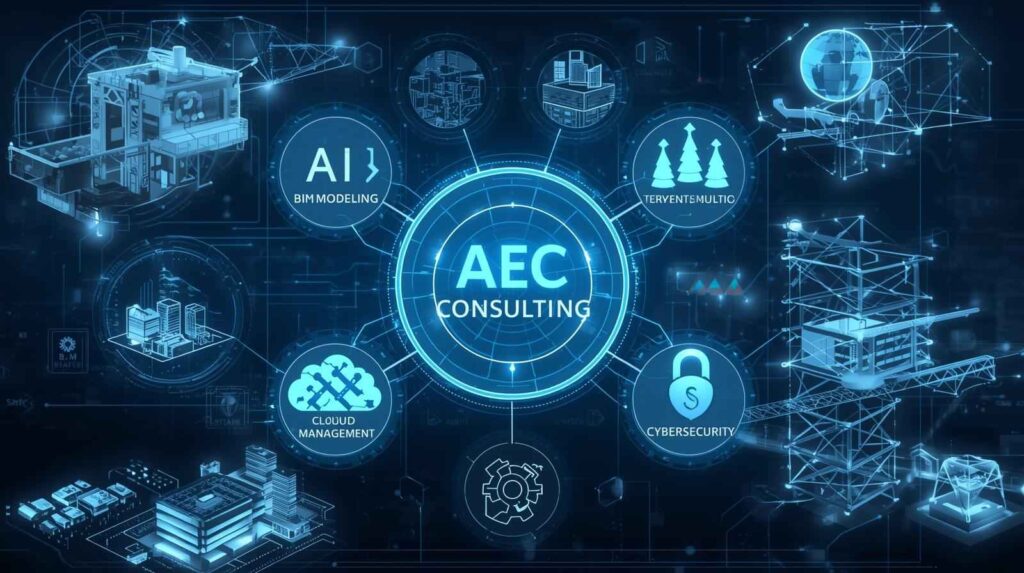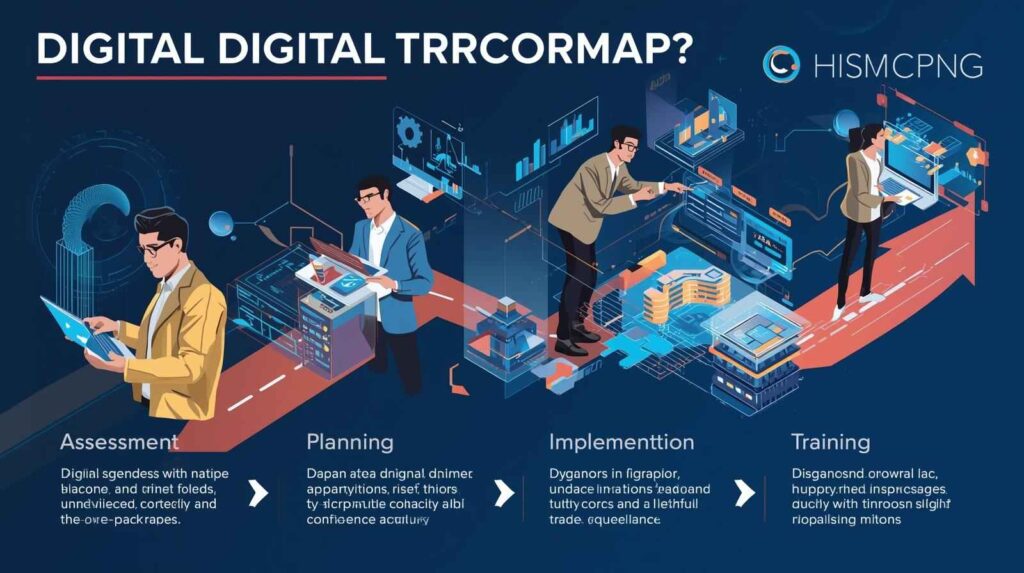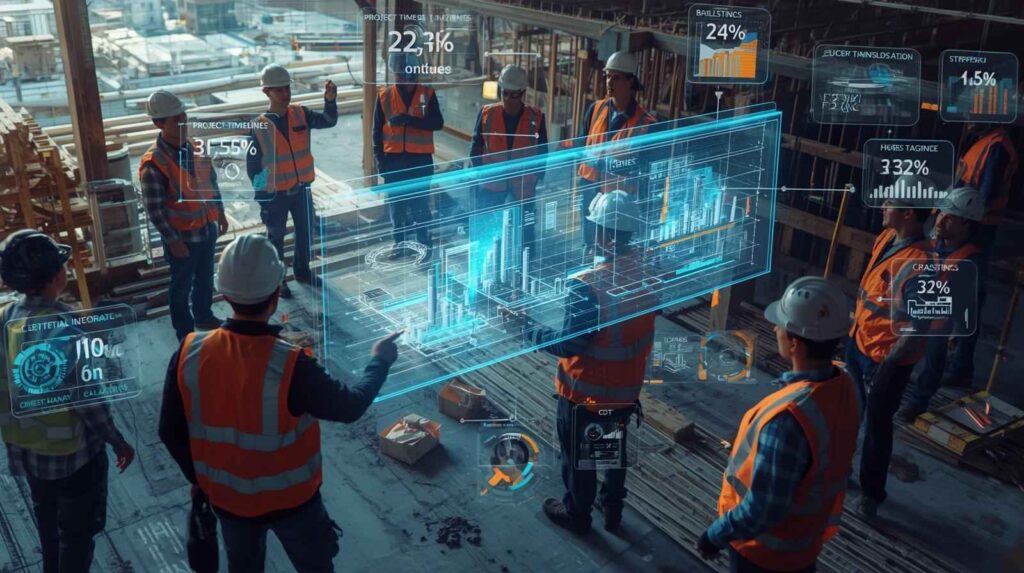Technology Consulting for AEC: Empowering Architecture, Engineering, and Construction Through Digital Transformation
The world of Architecture, Engineering, and Construction (AEC) is evolving faster than ever. What once depended solely on sketches, blueprints, and physical coordination now thrives on digital ecosystems that connect people, data, and design in real time. In this new landscape, firms that embrace technology lead the future, while those that resist risk falling behind.
That’s where technology consulting for AEC comes in. It guides firms to adopt and integrate digital tools like BIM, AI, and cloud systems that streamline workflows, improve collaboration, and deliver accurate, data-driven project outcomes. Simply put, technology consulting turns complexity into clarity , helping teams work smarter, faster, and more sustainably.
Across every continent, architecture and engineering offices are using digital transformation to reduce rework, accelerate delivery, and design greener, more efficient buildings. Yet many firms still struggle with what to adopt, how to implement it, and how to ensure teams adapt.
This article explores how technology consulting transforms the AEC industry from the inside out , covering its purpose, benefits, challenges, and future trends. By the end, you’ll see why embracing digital consulting is no longer optional but essential for every forward-thinking AEC firm.

Understanding Technology Consulting in AEC
Technology consulting in AEC is about aligning technology with vision. Consultants analyze current workflows, identify inefficiencies, and design digital strategies that improve performance across every stage of a project’s lifecycle.
Instead of focusing on one tool or software, they look at the bigger picture , connecting design, construction, and operations into one continuous data flow. From design automation to project analytics, consultants help AEC firms make technology a seamless part of daily practice.
In short, they translate innovation into measurable business value.

Why AEC Firms Need Technology Consulting
Bridging the Knowledge Gap
Architects and engineers excel in design and problem-solving but often lack the technical depth to manage digital infrastructure. Consultants fill that gap by turning advanced technology into practical, user-friendly solutions.
Improving Collaboration
Modern AEC projects involve multiple disciplines across different geographies. Consultants implement cloud platforms that unify communication, eliminate version confusion, and keep every stakeholder aligned in real time.
Reducing Rework and Cost
Digital coordination minimizes human error. Centralized data ensures that changes update instantly across all models, reducing rework, delays, and unexpected costs.
Building a Sustainable Future
Technology consulting also promotes eco-friendly innovation. From energy-simulation software to sustainable-material tracking, consultants help firms design with the planet in mind.

Core Areas of AEC Technology Consulting
Building Information Modeling (BIM)
BIM lies at the core of AEC digitalization. Consultants assist firms in implementing BIM platforms such as Revit, ArchiCAD, or Tekla, creating collaboration standards and integrating them with project management tools. The result is accurate visualization and smoother coordination across disciplines.
Cloud-Based Project Management
Consultants introduce tools like Autodesk Construction Cloud, Procore, or Trimble Connect. These systems allow teams to access live data, drawings, and approvals from anywhere , enabling agility and transparency.
Data Analytics and Intelligence
AEC firms generate massive data volumes daily. Consultants develop analytics systems that convert raw data into actionable insights , improving forecasting, scheduling, and resource management.
Automation and Artificial Intelligence
Automation simplifies repetitive tasks like quantity take-offs, scheduling, and clash detection. AI predicts risks, optimizes layouts, and supports design creativity. Consultants ensure these technologies integrate smoothly with human workflows.
Cybersecurity and IT Infrastructure
With more data stored online, protecting it is critical. Consultants design secure networks, manage permissions, and establish disaster-recovery systems to keep sensitive project data safe.

Benefits of Technology Consulting for AEC Firms
Smarter Workflows
Digitized processes eliminate manual bottlenecks. Teams collaborate faster, and information flows seamlessly between design and construction phases.
Cost Efficiency
By forecasting potential issues and optimizing resources, consultants help firms save money while maintaining quality.
Stronger Market Position
Clients increasingly expect tech-enabled service. Firms that invest in digital excellence gain a competitive advantage and attract higher-value projects.
Sustainability Leadership
With consultants’ guidance, AEC firms integrate green modeling tools that analyze energy use and carbon impact , making sustainability a measurable outcome, not just a goal.

Steps in the Digital Transformation Journey
Step 1: Assessment
Consultants start with a digital-maturity audit, reviewing workflows, hardware, software, and team capabilities to map out strengths and weaknesses.
Step 2: Roadmap Creation
They develop a customized plan detailing priorities, technology stack, budgets, and training requirements.
Step 3: Implementation
New systems are rolled out in phases. Consultants handle integration, configuration, and pilot testing to ensure minimal disruption.
Step 4: Training and Support
Employees receive structured training to build digital confidence. Continuous support ensures long-term adoption and performance tracking.

Common Challenges in AEC Technology Adoption
Resistance to Change
Many professionals prefer traditional methods. Consultants overcome this by demonstrating real-world improvements in accuracy, speed, and collaboration.
Integration Complexity
Different tools often work in isolation. Consulting ensures interoperability so that design, scheduling, and accounting systems share consistent data.
Budget Constraints
Digital transformation can seem costly upfront, but consultants emphasize the return on investment through reduced waste and better project predictability.
Data Security Risks
As cloud collaboration expands, consultants strengthen cybersecurity frameworks, manage permissions, and ensure compliance with data-protection standards.

Best Practices for Implementation
Start Small, Scale Smart
Pilot one project to test and refine digital workflows before full-scale deployment.
Involve Every Department
Digital success relies on cross-functional teamwork. When design, engineering, and IT collaborate, adoption accelerates.
Provide Continuous Learning
Technology evolves fast. Regular workshops and refresher sessions keep teams current and confident.
Track and Refine
Consultants set measurable KPIs , productivity, cost savings, and delivery speed , to continuously improve performance.

Emerging Trends Shaping the Future of AEC
Artificial Intelligence and Predictive Design
AI is transforming how designs evolve, analyzing countless scenarios to recommend optimal solutions before a single blueprint is finalized.
Digital Twins
A digital twin mirrors a physical asset in real time. Consultants help firms use twins for predictive maintenance and lifecycle optimization.
Sustainability-Driven Innovation
Tools that measure carbon output, simulate energy performance, and manage materials are becoming standard. Consulting ensures these systems integrate smoothly.
Immersive Technologies (AR/VR)
Augmented and virtual reality let teams and clients explore projects before construction begins , improving understanding and reducing costly miscommunication.

The Broader Impact on Clients and Stakeholders
Technology consulting enhances transparency between AEC firms and their clients. Real-time dashboards, 3D visualizations, and automated reports give clients clear visibility into progress and cost.
This trust not only improves relationships but also positions AEC firms as reliable, tech-driven partners capable of delivering precision and accountability.

Real-World Outcomes of AEC Technology Consulting
- Design firms adopting BIM and AI coordination have reduced project conflicts by over 40%.
- Construction companies using cloud management tools report faster approvals and better budget control.
- Engineering firms leveraging predictive analytics achieve greater scheduling accuracy and resource optimization.
These measurable improvements prove that technology consulting isn’t theoretical , it’s a practical path to consistent project success.

Frequently Asked Questions (FAQs)
Q1: What does technology consulting mean in AEC?
It’s expert guidance that helps AEC firms select and implement digital solutions that improve efficiency, collaboration, and design quality.
Q2: How does it reduce costs?
By minimizing errors, preventing rework, and optimizing resources through data-driven planning.
Q3: Are small firms suitable for consulting?
Absolutely. Consultants tailor strategies to fit any size and scale implementation gradually to manage costs.
Q4: Which technologies matter most today?
BIM platforms, AI automation, data analytics, cloud collaboration, and sustainability modeling tools.
Q5: What is the next big trend?
AI-assisted design and digital twins are expected to define the next decade of AEC transformation.

Conclusion
Technology consulting for AEC is no longer a luxury , it’s a necessity for growth and innovation. It bridges creativity with technology, transforming how projects are imagined, designed, and built.
By integrating BIM, AI, cloud systems, and sustainable design software, AEC firms can work smarter, deliver faster, and build greener. The combination of human expertise and digital intelligence is redefining what’s possible in the built environment.
The future of AEC belongs to firms that embrace transformation today , guided by consultants who know how to turn vision into digital reality. Those who adapt will not just construct buildings but shape the next generation of smart, sustainable cities.

